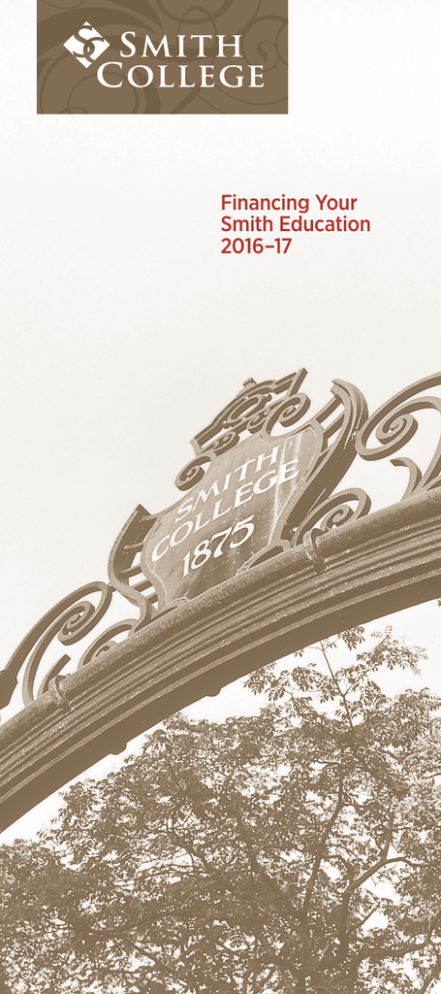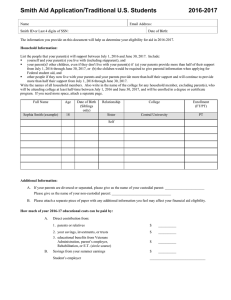Financing Your Smith Education 2016–17
advertisement

Financing Your Smith Education 2016–17 Planning for College Costs Financing a college education can be complicated. This worksheet can help you figure out what you would owe for 2016–17 billed charges at Smith. A. Total costs. Add the tuition and fees to get the total amount that the college will bill you. Tuition$ 47,620 Student Activity Fee + 284 Room and Board + 16,010 Health Insurance* + $ _______________ * Total Costs $ _______________ (A) *2016–17 figures are not yet set. 2015–16 figures: $2,192 (full coverage); $244 (on-campus supplemental plan). Students covered under other insurance plans may waive this coverage by submitting the Smith waiver form by the deadline. B. Total financial aid. Total the grants, scholarships and loans that have been awarded to the student. Scholarship(s) and grant(s) $ _______________ Federal Direct Loan (less applicable fees) + $ _______________ College or other loan (less fees, if applicable) + $ _______________ Total financial aid $ _______________ (B) Work-Study/Campus Work. Do not include work-study/campus work. Campus job earnings are paid directly to the student as earned, not credited to the student’s account, unless special arrangements have been made. Most students use their earnings for their books, supplies and other personal expenses. Outside Scholarships. Outside scholarships a student is awarded may further reduce the amount you owe. Please read the outside aid policy on page 10. 2 C. Amount you owe. Determine how much you will have to pay by subtracting the total financial aid (B) from the total costs billed (A). (A) $_____________ – (B) $ ____________ = (C) $ ____________ Amount C is what you should plan on paying for billed costs for the academic year. Assume half of this amount per semester. D. Family Resources. Determine how much you will be able to pay from your family assets, the student’s assets and her summer earnings. From Parent/Family Assets $ _______________ From Student’s Assets + $ _______________ From Student’s Summer Earnings + $ _______________ Total Contribution from Assets and Summer Earnings $ _______________ (D) E. Current income contribution. Subtracting total assets (D) from the total amount you owe (C) gives you the amount remaining to pay from your current income. (C) $_________ – (D) $_________ = (E) $__________ Other Costs Not Billed In addition to your billed fees, you should budget for the cost of books and supplies, mandatory and optional house dues, travel and personal expenses. Books and supplies usually cost a minimum of $400 per semester, varying with the courses you take and the availability of secondhand books. The $500 you send when you accept admission to Smith includes a $300 general deposit and a $200 room deposit. The room deposit reserves a place for you in a student house and is credited to your bill, one-half each semester of your first year. The general deposit is refunded after graduation. 3 Financing Resources Many families elect to finance their share of college costs through a combination of loans and payment plans. Student Financial Services will send detailed financing information to enrolling students in sufficient time to plan for college bills. Payment plans offer short-term financing options. Visit www. smith.edu/sfs/financing.php for information on flexible payment plan options. The federal PLUS loan program offers parent loans for educational purposes. Please see the following page for information regarding this loan. Please Note Smith College uses e-billing. E-bills will be sent to students’ Smith email accounts. Additional email addresses (authorized users) may be added by the student. The first notification of the fall bill will be sent out by mid-July. Please be sure that the student is aware of this and is checking her Smith College email account regularly. No paper bills are mailed. 4 Parent Direct PLUS Loan Eligibility Creditworthy parents of dependent students. Credit check is performed, but no formal debt-to-income analysis is required. Annual Loan Limits Cost of attendance less financial aid. Interest Rate Fixed at 6.8% for loans disbursed between July 1, 2015, and June 30, 2016. Interest rates for the 2016–17 academic year will not be available from the Department of Education until May 2016. Fees 4.272% origination fee, added to loan. Disbursement 50% of the annual loan (less fees) is disbursed to Smith College each semester. 5 Student Loans Federal Direct Ford Loan (Stafford Loan) The Federal Direct Ford Loan (Stafford Loan) is a fixed-rate loan designed to help students meet the costs of postsecondary education. Eligibility. All students enrolled at least half-time in postsecondary education are eligible to borrow under this program. There are two types of loans under this program: subsidized and unsubsidized. Subsidized loans do not accrue interest until six months after the student leaves school, whereas unsubsidized loans start to accrue interest from the date the loan pays into the student’s account. In order to determine eligibility for these loans, the federal government requires that you complete the Free Application for Federal Student Aid (FAFSA). You may also be required to complete the federal verification process, if requested. Loan Limits. The federal loan limits listed below are maximums. Your financial aid package may show a lesser amount based on the college’s policy of awarding need-based aid. You may still be eligible to borrow up to the federal maximum, although you may not be eligible for the interest subsidy on the entire loan. Undergraduate Loan Limits Maximum Annual Amount ($2,000 of annual maximum must be unsubsidized) $5,500 $6,500 $7,500 $7,500 $7,500 (1st year)* (2nd year) (3rd year) (4th year) (5th year) Maximum Cumulative Amount $31,000 (maximum $23,000 subsidized) Because of Smith’s awarding policies, your loan amount may be less than the maximum. To increase your loan, please contact Student Financial Services to determine your eligibility. 6 Interest Rate. This rate is fixed at 4.29 percent for undergraduate students for both subsidized and unsubsidized loans first disbursed July 1, 2015, to June 30, 2016. Interest rates for the 2016–17 academic year will not be available from the Department of Education until May 2016. The federal government pays the interest on the subsidized loan while the student is enrolled at least half-time in postsecondary education if the student qualifies for the in-school subsidy. Those who do not qualify for a subsidized loan have the option of accruing interest while enrolled or paying interest-only on a quarterly basis. Loan Fees. Loans are paid to a student’s account after a 1.068 percent origination fee is taken out. Disbursement. Loan proceeds are disbursed in two equal installments, one per semester. Students must sign an electronic master promissory note and complete an entrance interview before loan proceeds may be applied to their student accounts. Online entrance counseling and promissory note information is available at www. smith.edu/sfs. Repayment. Repayment begins six months after you graduate, withdraw or drop below half-time enrollment. Supplemental Unsubsidized Federal Direct Ford Loan Independent students may be eligible to borrow additional amounts through this program. Dependent students whose parents are denied for a federal PLUS Loan may also request approval from Student Financial Services for this loan. Undergraduate Loan Limits Maximum Annual Amount Maximum Cumulative Aggregate Amount $4,000 (1st and 2nd years) $5,000 (3rd, 4th, 5th years) $57,500 (maximum $23,000 subsidized) There is no in-school interest subsidy. Students have the option of allowing interest to accrue during periods of enrollment or of paying interest quarterly. 7 Campus Employment and Federal Work-Study Campus employment allows students to earn money for educational and personal expenses. Smith student workers are paid directly every two weeks. Earnings vary depending on the numbers of hours worked, typically limited to 10 hours per week. Students may make payroll deduction arrangements to have part or all of their income applied directly to their student accounts. Work-study earnings are not applied to student accounts unless the student completes a payroll deduction form. Students who are eligible for need-based financial assistance receive a federal work-study or campus work award as part of their financial aid package. These students are given preference in obtaining campus employment. Federal work-study students may also work in the off-campus America Reads tutoring program. Students not eligible for the federal work-study or campus work program may obtain campus employment after the first four weeks of the fall semester and after the first two weeks in the spring, depending on job availability. Visit www.smith.edu/student-employment for information on both on- and off-campus jobs. 8 Grants Grants are gifts and are not repaid. The grant portion of your aid award may be made up of grants from Smith resources as well as federal and state aid programs administered by Smith. As part of the standard financial aid process, eligibility for these grants is determined on the basis of need as calculated by Student Financial Services. (Note: While amounts and sources of grant aid within a financial aid package may change, total grant aid only changes if the calculation of need changes.) Smith Grant This is direct gift aid from the college. Gifts and donations from alumni, parents and friends of Smith College provide these grant funds. Federal Pell Grant This federally funded grant provides awards up to a maximum of $5,815 to eligible undergraduates. Any amount indicated on your Financial Aid Award letter is estimated based on the information provided in your financial aid application. If, on verification with actual current tax returns and the Free Application for Federal Student Aid (FAFSA), we find that your Pell Grant eligibility changes, your Smith Grant will be adjusted accordingly. Federal Supplemental Educational Opportunity Grant (FSEOG) Recipients of this federally and institutionally funded program are selected by Smith and must demonstrate significant financial need. This grant is awarded only to those students who are also eligible for a Pell Grant. The maximum award is $4,000 per year. FSEOG awards appear in final awards and replace Smith grants dollar for dollar. State Scholarship/Grant This award comes directly from the student’s state of legal residence. Any amount indicated on your Financial Aid Award letter is estimated based on information provided in your financial aid application. If your state has a state grant program, you must file the FAFSA and any other required applications by your state’s deadlines in order to be eligible. Smith College cannot replace state grants lost because of late or incomplete applications. The state grant replaces the Smith grant dollar for dollar. 9 Outside Aid Policy If you receive any assistance from an organization outside of the college, this aid must be taken into consideration in calculating your financial aid award. For this reason, you are required to report such aid. The treatment of outside aid depends on the source as outlined below. Outside Aid Outside aid will first reduce or replace the self-help portion of your award (federal work-study and federal subsidized loan). If the outside aid exceeds the total self-help portion of your award, we will allow the aid to go toward a one-time computer purchase or toward the cost of the on-campus health insurance plan. If you do not purchase or have already purchased a computer, and if you do not accept the on-campus health insurance plan, or if your outside aid exceeds these costs, the outside aid will replace your Smith grant on a dollar-for-dollar basis. Outside aid includes both awards based on student merit and aid based on parent employment, such as tuition benefits. Students must notify Student Financial Services of all outside awards. If you notify us by June 1, the aid will be reflected in your official award and on your first bill. If you notify us after September 1, the outside aid may be used to reduce your Smith Grant dollar for dollar. Veteran’s Administration Benefits VA benefits generally fall under our Outside Aid Policy, above. Yellow Ribbon benefits are administered separately. Please see our website for additional information. 10 Contact Us! Student Financial Services is happy to provide information and answer your questions. Website: www.smith.edu/sfs. This site includes useful information for prospective and newly enrolled students and up-to-date information about deadlines, forms and student employment. Links to other resources provide a variety of information about education financing. Email: sfs@smith.edu. No busy signals, no voice mail—you can write to us anytime. Telephone: 413-585-2530 Monday, Tuesday, Thursday, Friday: 8:30 a.m. to 4 p.m. Wednesday: 10 a.m. to 4 p.m., Eastern Standard Time Fax: 413-585-2566 Write: Student Financial Services Smith College Northampton, MA 01063 Information in this brochure is accurate as of February 2016. Please visit our website for the most current information. 11 Student Financial Services 10 Elm Street Smith College Northampton, Massachusetts 01063 Telephone: 413-585-2530 Fax: 413-585-2566 Notice of Nondiscrimination Smith College is committed to maintaining a diverse community in an atmosphere of mutual respect and appreciation of differences. Smith College does not discriminate in its educational and employment policies on the bases of race, color, creed, religion, national/ ethnic origin, sex, sexual orientation, age, or with regard to the bases outlined in the Veterans Readjustment Act and the Americans with Disabilities Act. Smith’s admission policies and practices are guided by the same principle, concerning women applying to the undergraduate program and all applicants to the graduate programs. For more information, please contact the adviser for equity complaints, College Hall 103, 413-5852141, or visit www.smith.edu/diversity. 2M5424–3/2016 Email: sfs@smith.edu



